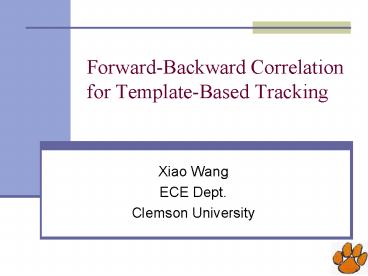Forward-Backward Correlation for Template-Based Tracking - PowerPoint PPT Presentation
Title:
Forward-Backward Correlation for Template-Based Tracking
Description:
Forward-Backward Correlation for Template-Based Tracking Xiao Wang ECE Dept. Clemson University Introduction Object tracking: An important computer vision problem ... – PowerPoint PPT presentation
Number of Views:80
Avg rating:3.0/5.0
Title: Forward-Backward Correlation for Template-Based Tracking
1
Forward-Backward Correlation for Template-Based
Tracking
- Xiao Wang
- ECE Dept.
- Clemson University
2
Introduction
- Object tracking An important computer vision
problem - Security and surveillance
- Medical therapy
- Retail space instrumentation
- Video abstraction
- Traffic Management
- Video editing
- Template-Based Tracking
- A classic technique
- Idea of template-based tracker
3
Related Work
- Jepson et al. Robust Online Appearance Models for
Visual Tracking, CVPR 2001 - Ho et al. Visual Tracking Using Learned
Subspaces, CVPR 2004 - Davis et al. Tracking Rigid Motion using a
Compact-Structure Constraint, ICCV 1999 - Avidan et al. Ensemble Tracking, CVPR 2005
4
Overview of the Approach
Forward Correlation Module
Textured Background?
Next Frame
Yes
No
5
Template-Based Tracking
- Template Selection first frame vs. previous
frame - Motion Model
- Similarity transformation
scaling
displacement
6
Template-Based Tracking
- Cross Correlation SSD
reference image
displacement
search image
7
Template-Based Tracking
- Similarity measure s(?x, ?y)
- Correlation Coefficient c(?x, ?y)
Mean of template
Mean of image region
8
Forward Correlation
- Forward Correlation
- Reference frame previous frame
- Goal find transformation vector (dx, dy, a)
- Approach cross-correlation
Put into correlation coefficient framework
- Template Update
9
Forward Correlation
Out-of-plane rotation
- Drifting Problem
- Forward correlation approximates rotation with
translation. - Forward correlation does not check the
reliability of the template. - We need a mechanism to question the assumption of
forward correlation.
Previous frame
Current Frame
10
Backward Correlation
- Consider our problem as motion segmentation
- Goal of motion segmentation
- Why is motion segmentation of video sequences
difficult? - Under-constrained
- Occlusion Disocclusion
- Image noise
- A two-step procedure
- Determine the motion vectors associate with each
pixel or feature point. - Group pixels or feature points that perform
common motion.
11
Backward Correlation
- Kanade-Lucas-Tomasi (KLT) feature tracker
- Idea minimize the dissimilarity of feature
windows in two images - Assumption mutual correspondence
12
Backward Correlation
- Now consider the dissimilarity under the template
window. - Decompose the template window into 2 partitions
foreground
background
- Rewrite dissimilarity as
high
low
13
Backward Correlation
- Background is moving at a different velocity than
the foreground. - Foreground pixels have similar velocity and
generate low SSD error. - Correlation between background pixels using
foreground velocity generates high SSD error. - Goal group foreground pixels which are moving at
similar velocities
Reference frame I(x)
Difference image D(x)I(x)-J(xd)2
Current image J(x)
14
Backward Correlation
- Formulations for backward correlation
Set of template candidates
Correlation coefficient (likelihood)
15
Untextured Backgrounds
- Limitation of backward correlation
- Fails if background has little texture.
- Why? --- Examine the assumption.
- Backward correlation has no reason to prefer the
foreground to the background which is untextured.
low
Also low if untextured
16
Untextured Backgrounds
- Likelihood of backward correlation textured vs.
untextured
Foreground
Template containing background pixels
Textured background
Untextured background
17
Gradient Module
- Motivation
- Seek a module focusing on the boundary of the
target being tracked. - An edge-based segmentation problem.
- Prior information an ellipse model.
- Gradient Module
Unit vector normal at pixel i
Intensity gradient
18
Combining Modules
- Gradient module and backward correlation module
have orthogonal failure modes. - Textured or Untextured?
- Use sum of the gradient magnitude of the
neighborhood region. - Combination of forward correlation module and
backward correlation module is straightforward. - Combination of forward correlation module and
gradient module requires the normalization of the
matching scores.
19
Combining Modules
- Normalize the matching score (likelihood)
- Finial state is decided by
20
Adaptive Scale
- Vary the scale by 10 percent during search
process. - Filter the result to avoid oversensitive scale
adaptation. - Comaniciu et al. Kernel-based object tracking,
TPAMI 2003
Size of the best state given by the alg.
Size of the object in the previous frame
21
Experimental ResultsCluttered Background
- Traditional template-based tracker slides off
target
22
Experimental ResultsCluttered Background
- Our algorithm remains locked onto target
23
Experimental ResultsCluttered Background
- Tracking error plot
- Our algorithm (blue, solid) vs. traditional
template-based tracker (red, dashed)
Error in x direction
Error in y direction
24
Experimental ResultsUntextured Background
- Tracking results of traditional template-based
tracker
25
Experimental ResultsUntextured Background
- Tracking results of our algorithm
26
Experimental ResultsOcclusion
27
Experimental ResultsTracking a vehicle
28
Conclusion
- Presented an extension to template-based
tracking. - Achieved robustness to out-of-plane rotation.
- Effective tracking in both textured and
untextured environment. - Remaining challenges
- Robustness when scale changes.
- Use motion discontinuities to improve
performance. - Analysis of parameter sensitivity for untextured
backgrounds.
29
- Questions?
30
- Thank You!































